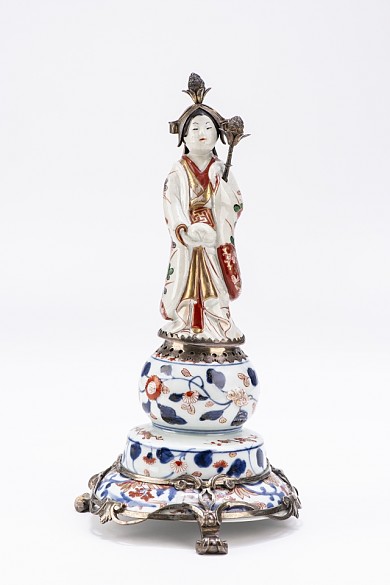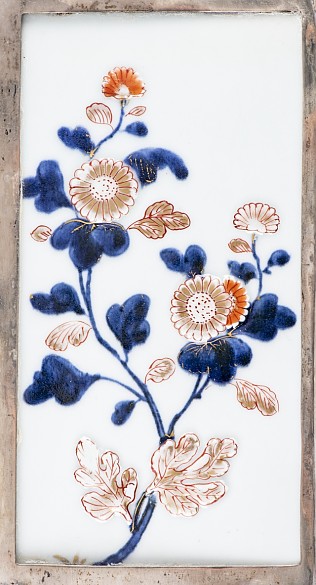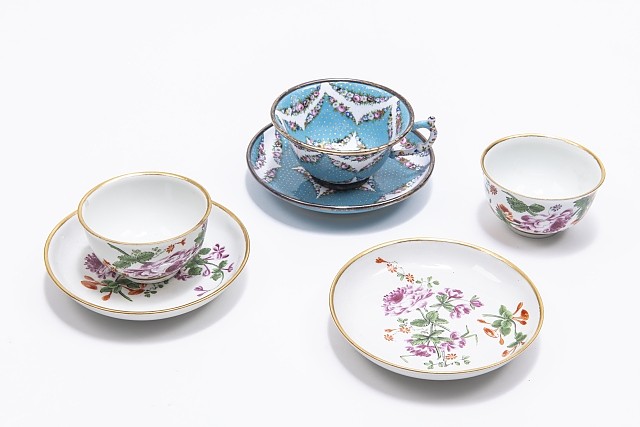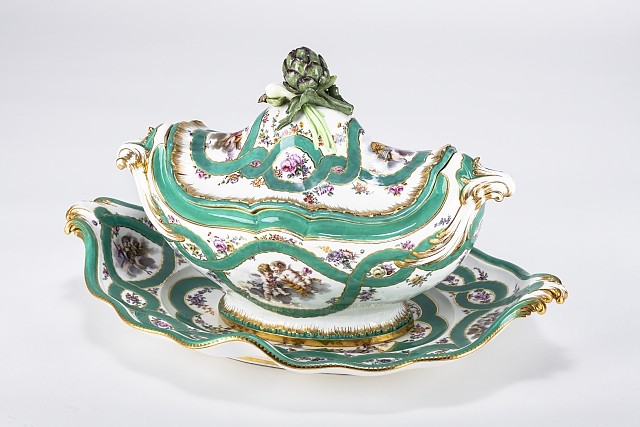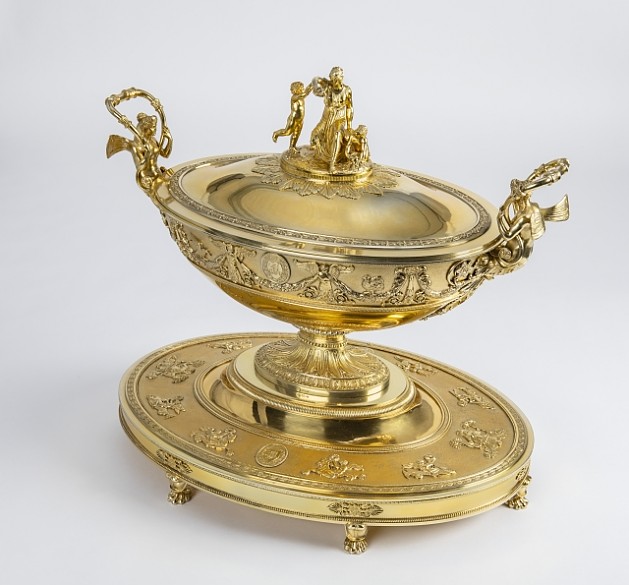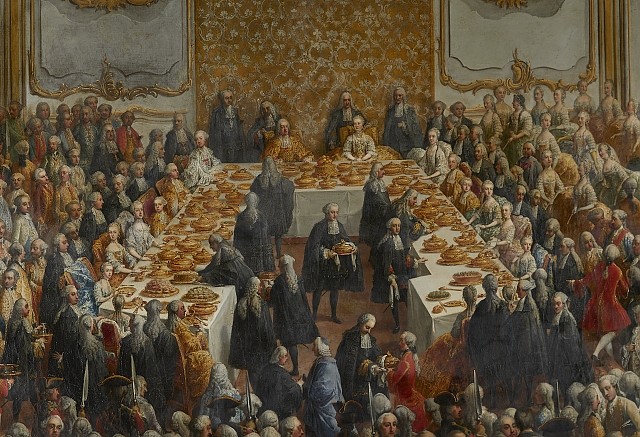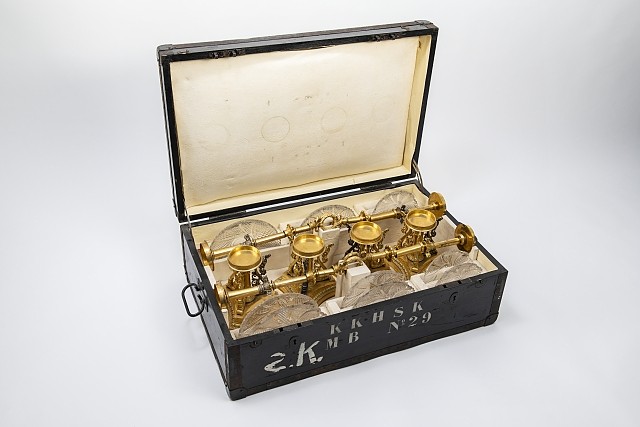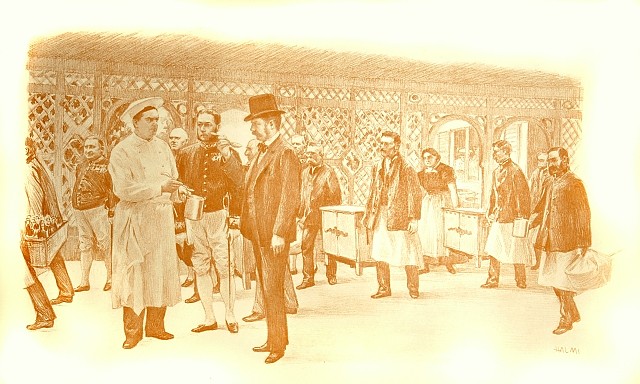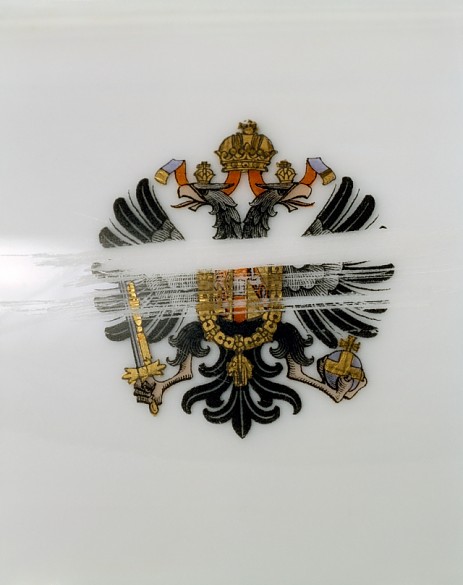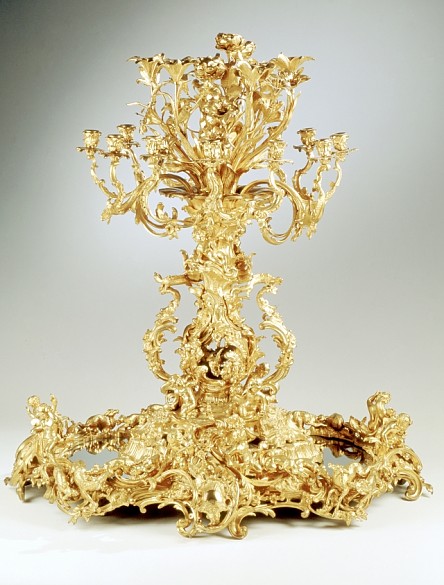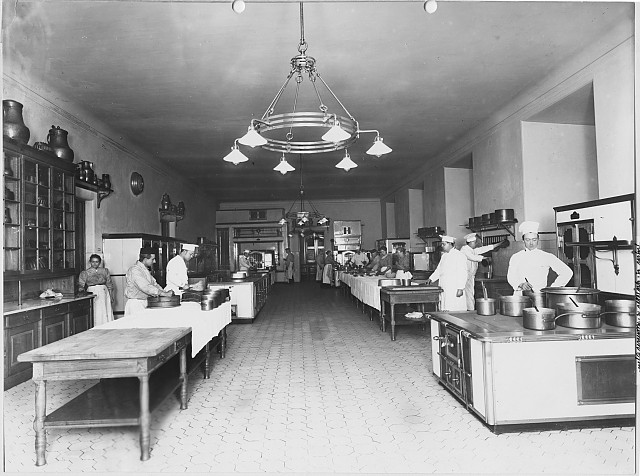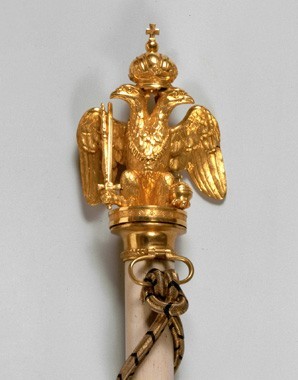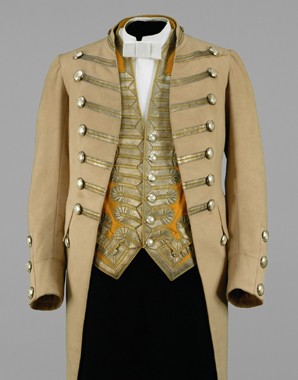Treasures of the Imperial Table
The most outstanding objects from the inventory of the former Imperial Court collection of silver and tableware on show at Schloss Hof Estate. Exquisite artworks made of silver, porcelain and glass vividly reflect the glittering world of courtly dining culture from the Baroque era through to the end of Habsburg rule in 1918.
The objects on show have a special character in that they are artefacts of consummate aesthetic quality and artistic craftsmanship but at the same time objects that were in constant use and therefore give us an inside view into the culture of the Imperial Court, both festive and everyday.
The variety of objects is astounding – a genuine treasure, not only in material value, but also in art-historical significance: no wonder, therefore, that the Vienna Silver Collection is one of the leading collections of this type in the world.
The objects from the Court Silver and Table Room are being supplemented with exhibits from the Schönbrunn Group collection that furthermore place them in fascinating contexts.
Fact & Figures
Curated by:
Katrin Harter, Birgit Schmidt-Messner and Martin Mutschlechner
The exhibition shows a great variety of outstandingobjects from the collection of the former Imperial Court Silver Room, now under the responsibility of the Bundesmobilienverwaltung, supplemented by numerous exhibits from the collection of the Schönbrunn Group as well asexhibits from private lenders.
The main themes of the exhibition:
Service with Personality
This part of the exhibition, presented in Schloss Hof, expands the range of topics in the 2023 season. The focus is on table services dedicated to personalities from the imperial family. The exhibited objects reflect their stages of life and private passions.
In the sign of the dolphin
“The dolphin, the laughing philosopher of the sea, is the personal emblem of the ocean-roaming princess,” wrote Constantin Christomanos, Greek teacher of Empress Elisabeth (1837-1898), in his book Das Achilles-Schloss auf Corfu (published in Vienna in 1896). In the shape of the Achilleion, a palace by the sea was created – entirely according to the ideas of the empress – and furnished all’ antico. Elisabeth felt great fascination for seafaring and maritime matters. This is also reflected in the design of the table service – on Elisabeth’s request, all parts were decorated with the emblem of a dolphin.
The Temptations of an Imperial Crown
At the age of 31, Ferdinand Maximilian (1832-1867) left Europe for Mexico to accede as Emperor of Mexico, a regency offered to him on the initiative of the French emperor Napoleon III. Driven by ambition to enhance his public image and realise his personal aspirations, but deceived by a referendum manipulated in his favour, he sailed towards this hazardous and in the end fatal adventure. Maximilian prepared himself for his role as Emperor of Mexico with the greatest enthusiasm. He planned the imperial household down to the last detail. During the passage to Mexico, he worked intensively on setting out the future appearance of his Mexican court and household, down to sketches of official tableware.
The “Flower Emperor” and porcelain
A selection of unique motif plates that were created under Emperor Franz II./I. (1768-1835) are shown. Under the motto “Art on your plate “, masterpieces from the production of the Imperial Porcelain Manufactory Vienna can be seen, including a selection of the famous floral plates. The “Flower Emperor” Franz II/I promoted an interest in gardens and horticulture. Precisely detailed depictions of flowers were recorded on plates. The luminance of the porcelain colours and the delicately applied gold borders enhanced the flower portraits with a rare elegance.
Gold Spoons & Imperial Tableware
In the exhibition section in Schloss Hof the focus is on the epoch of Maria Theresa. Besides exquisite exhibits from the voluminous collection of Asian porcelain, items from domestic and French porcelain manufacture reflect the significance of this material for the Viennese Court.
Between kimono and crinoline – porcelain in Asia and Europe
Invented in China and imitated in Japan, from the seventeenth century onwards a great variety and quantity of porcelain was exported to Europe. The exotic decorations and unusual vessel shapes fascinated the aristocracy and sparked off a craze for collecting.
Gifts seal friendships
Gifts of precious porcelain served as a form of diplomatic rapprochement in the eighteenth century. Tokens of this nature actually had an important political purpose in expressing endeavours to avoid or solve conflicts.
A gift chosen from the production of the domestic porcelain manufacture was a token of magnanimity for eighteenth-century monarchs and simultaneously served to enhance their own reputation. The French court was especially astute at implementing the decorative arts to express their claim as leaders on the cultural scene. Since objects from the French manufactory of Sèvres were coveted luxury products, they were ideal for the purpose.
The “Service with the Green Bands” is closely associated with the diplomatic revolution of the eighteenth century. The “renversement des alliances” – as it was termed in the French courtly and diplomatic language of the time – radically altered the system of alliances between the European powers. After centuries of hostility a rapprochement took place between France and Austria, which led to a reversal of political alliances.
The French king, Louis XV, set up a visual sign of diplomatic rapprochement: in 1758 he sent the “Service with the Green Bands” – an extremely valuable dinner and dessert service from the Sèvres factory – to Maria Theresa. Although primarily intended as rapprochement, this porcelain service was designed as well to make an impressive show in Vienna of the exquisite taste of the French court.
The Grand Vermeil Service
With its neoclassical all’antico repertoire of forms, the Grand Vermeil, originally for forty settings, is a major work of French goldsmithing.
Emperor Francis II/I ordered the magnificent Grand Vermeil service, once used by the Viceroy of Italy and Napoleon’s stepson, Eugène de Beauharnais, to be brought to Vienna in 1816. Dieses Service, gefertigt aus vergoldetem Silber, französisch als vermeilbezeichnet, war das hochrangigste Service des kaiserlichen Hofes. Under the regency of Emperor Franz Joseph, the Grand Vermeil service was stocked up to 140 settings. Today it encompasses 4,500 individual pieces.
Kitchen secrets behind the scenes - The emperor as host
The focus of the exhibition section located in Schloss Niederweiden is on the epoch of Emperor Franz Joseph. The focus is not only put on the splendour of courtly pomp, but also on the contrast between “being and seeming”: it deals with the challenges confronting the court servants, which meant living up to the great demands and standards holding sway at the Imperial Court.
The Court Silver and Table Room
Festively decked tables were an important part of courtly prestige. The high standard of Imperial “decorum” at the Viennese Court required a spectacular display on the tables. This was not limited to an exquisite menu alone, but also included an illustrious – and indeed lustrous – presentation, since the tableware was made of polished precious metal and fine porcelain. It was the task of the Court Silver and Table Room to provide the necessary utensils.
Nimble and noiseless
For a great festive banquet the Court machinery got into top gear. From the highest members of the court retinue and the footmen in livery down to the simple ancillary staff working in the background – everyone had a precisely defined task to fulfil. Many hands were needed to showcase the emperor as a brilliant host.
The emperor’s new table decoration – the New French Centrepiece
Emperor Franz Joseph’s ascent to the throne in 1848 led to major upheavals in table culture at the Viennese Court. The Imperial Table was again given more of a public character. The young emperor introduced Court Tables and “Serien” dinners with functionaries of the state administration, military and personages of public life. These “business dinners” set new challenges for the “decorum” of the Imperial Table.
A new, more modern, more flexible and modular table centrepiece had to be acquired: the so-called New French Centrepiece. Despite its seemingly impractical expansive forms, the New French Centrepiece is extremely functional – because, of course, the voluminous parts have to be set on the table quickly and flexibly depending on their purpose. They can thus be dismantled easily and put together in a kind of modular system.
French Haute cuisine versus “home cooking” Viennese style
A high standard of quality and presentation of the dishes was a must – after all, the Viennese Court was in competition with other European courts. The frequently read assertion that Viennese cuisine and all its gastronomic influences from the Crown Lands were dominant at the Habsburg Court is not confirmed if we look at the menus. Influences from local cooking traditions were noticeable at most in the private sphere. French cuisine dominated for official and formal meals, only occasionally supplemented by local dishes which gave the menu a specific Austrian note.
The “Flagship“ – the Great Court Kitchen in the Hofburg
“The kitchen is not a single room, it is a small city of rooms. When the word is given out that food is to be prepared for the emperor, this means that for a couple of hundred people the spits are turned, ovens and grills glow red, some dishes are heated up and others frozen into ice.”
(Quote from "Viribus unitis - Das Buch vom Kaiser", 1898)
Treasures of the Imperial Table
March 18, 2022 to November 1, 2023
An exhibition at two locations – Schloss Hof and Schloss Niederweiden
Website with visitor information:
www.schlosshof.at
A special exhibition of the Schönbrunn Group under the direction of Klaus Panholzer.
in cooperation with the Cultural Heritage Department of the Federal Ministry for Digital and Economic Affairs and the Bundesmobilienverwaltung (BMobV).
Related content





